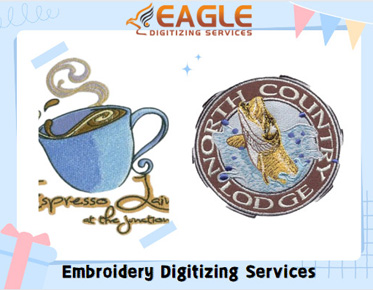The Psychology of Color: Maximizing Impact in Embroidery Digitizing
Embroidery digitizing is a captivating blend of artistry and technology, where every stitch tells a story. In this intricate craft, color isn't just a visual element; it's a powerful tool that can evoke emotions, convey messages, and captivate audiences. Understanding the psychology of color is key to unlocking the full potential of embroidery digitizing, enabling artisans to create designs that resonate deeply with viewers.
Understanding Color Psychology
Color psychology delves into the intricate ways in which different hues influence human emotions and behaviors. It's a fascinating field that explores the subconscious connections between colors and our perceptions. Each color possesses its own unique set of psychological properties, from the calming effects of blue to the passionate energy of red. By understanding these nuances, embroiderers can strategically leverage colors to elicit specific emotional responses from viewers.
Impact
of colors on emotions and behavior
Colors have the remarkable ability to influence our moods, attitudes, and behaviors. Warm colors like red and orange can evoke feelings of excitement, passion, and energy, while cool colors like blue and green have a calming and soothing effect. Bright, vibrant colors tend to grab attention and evoke positive emotions, while muted tones create a sense of tranquility and sophistication. By carefully selecting and combining colors, embroiderers can craft designs that resonate with viewers on a visceral level.
Applying Color Psychology in Embroidery Digitizing
Choosing
colors based on desired emotional response
When digitizing embroidery designs, selecting the right colors is essential for conveying the intended message and eliciting the desired emotional response from viewers. Whether aiming for excitement, serenity, or sophistication, embroiderers must carefully consider the psychological impact of each color choice. By aligning color selection with the intended emotional tone of the design, embroiderers can create pieces that resonate deeply with their audience.
Harmonizing
colors for maximum impact
In embroidery digitizing, harmonizing colors is crucial for creating visually appealing designs that capture attention and convey meaning effectively. Harmonization involves balancing contrasting colors, adjusting saturation levels, and considering color temperature to create a cohesive and balanced composition. By harmonizing colors thoughtfully, embroiderers can maximize the impact of their designs and create visual experiences that leave a lasting impression.
Color Symbolism in Different Cultures
Cultural
significance of colors
Colors hold diverse meanings and symbolism across different cultures, making it essential for embroiderers to consider cultural contexts when selecting colors for their designs. For example, while white may symbolize purity and innocence in Western cultures, it is often associated with mourning and funerals in many Asian cultures. Understanding these cultural nuances ensures that embroidery designs are culturally sensitive and resonate with diverse audiences.
How to
adapt color choices for diverse audiences
Adapting color choices to resonate with diverse audiences requires a nuanced understanding of cultural symbolism and preferences. Embroiderers must research and familiarize themselves with the cultural significance of colors in the regions where their designs will be viewed. By incorporating culturally appropriate colors and symbolism, embroiderers can create designs that resonate with and appeal to diverse audiences worldwide.
Practical Tips for Effective Color Usage
Contrast
and visibility considerations
In embroidery digitizing, contrast is essential for ensuring visibility and legibility, especially in intricate designs. High-contrast color combinations enhance visibility and make designs stand out, while low-contrast combinations can result in muddy or indistinct visuals. Embroiderers must consider factors such as thread thickness, stitch density, and background fabric color when selecting contrast-enhancing color combinations.
Color
combination techniques
Mastering color combination techniques is essential for creating visually striking embroidery designs. Techniques such as complementary colors, analogous colors, and triadic color schemes can be used to create harmonious and visually appealing compositions. By experimenting with different color combinations, embroiderers can discover unique palettes that elevate their designs and captivate viewers.
Branding and Color Consistency
Importance
of color consistency in branding
Consistency in color usage is crucial for establishing and reinforcing brand identity across different mediums. Embroidery designs must align with the established color palette and branding guidelines of the client to maintain brand recognition and cohesion. Consistent use of colors builds brand trust and strengthens brand association with audiences over time.
How to
maintain consistent colors across different mediums
Maintaining color consistency across different mediums can be challenging, but it's essential for preserving brand integrity and recognition. Embroiderers can use color management techniques such as color calibration, color matching software, and standardized color palettes to ensure consistency across various platforms and materials. By adopting these practices, embroiderers can deliver embroidery designs that align seamlessly with their clients' brand identities.
Trends in Color Usage
Current
trends in embroidery color usage
Color trends in embroidery digitizing evolve constantly, influenced by factors such as fashion, design aesthetics, and cultural shifts. Keeping abreast of current color trends allows embroiderers to create designs that resonate with contemporary audiences and stay relevant in the ever-changing market. From bold, vibrant hues to soft, muted tones, embroiderers can draw inspiration from current trends to create designs that captivate and delight viewers.
Opportunities
for innovation and creativity in embroidery digitizing
While it's essential to stay informed about current color trends, there's also ample room for innovation and creativity in embroidery digitizing. Experimenting with unconventional color combinations, exploring new techniques, and pushing the boundaries of traditional design conventions can lead to truly unique and memorable embroidery creations. By embracing innovation and creativity, embroiderers can carve out their own distinctive style and make a lasting impact in the world of embroidery.
Tools and Resources for Color Selection
Digital
tools for color selection
Embroiderers have access to a wide range of digital tools and software for color selection, making the process more efficient and streamlined. Color palette generators, color pickers, and design software offer valuable assistance in choosing and harmonizingcolors for embroidery digitizing. These tools empower embroiderers to explore endless color possibilities and create designs that resonate with their vision.
Online
resources for color inspiration
In addition to digital tools, there is a wealth of online resources available to embroiderers for color inspiration and creative ideas. Websites, blogs, and social media platforms dedicated to design and color theory provide endless sources of inspiration and insights into current trends. By immersing themselves in these online communities, embroiderers can stay inspired and discover new color palettes and design techniques to incorporate into their work.
Overcoming Challenges in Color Selection
Dealing
with limited color options
Embroiderers may encounter challenges when working with limited color options, such as restricted thread palettes or budget constraints. However, limitations can also spark creativity and innovation, prompting embroiderers to experiment with unconventional color combinations and techniques. By embracing constraints and thinking outside the box, embroiderers can turn limitations into opportunities for artistic expression and exploration.
Addressing
client preferences and feedback
Navigating client preferences and feedback is another challenge embroiderers may face when selecting colors for their designs. Effective communication and collaboration are essential for understanding clients' vision and ensuring that their expectations are met. By actively soliciting feedback, incorporating client preferences, and offering expert guidance, embroiderers can create designs that exceed client expectations and leave a lasting impression.
Testing and Iteration
Importance
of testing color combinations
Testing color combinations is a crucial step in the embroidery digitizing process, allowing embroiderers to assess the visual impact and effectiveness of their designs. By stitching out test samples and evaluating them under different lighting conditions, embroiderers can identify color inconsistencies, readability issues, and areas for improvement. Testing ensures that the final embroidery design meets quality standards and delivers the desired emotional impact to viewers.
Iterative
approach to refining color choices
Embroidery digitizing is an iterative process that requires patience, experimentation, and refinement. Embroiderers may need to iterate on color choices multiple times, making adjustments based on feedback and test results, until they achieve the desired aesthetic and emotional effect. By embracing an iterative approach, embroiderers can continually refine their color choices and create embroidery designs that resonate deeply with their audience.
Conclusion
Incorporating the principles of color psychology into embroidery digitizing not only enhances the visual appeal but also elevates the emotional impact of designs. With Eagle Digitizing, a leading provider of embroidery digitizing services, artisans can harness the power of color to create captivating and inspiring designs. By leveraging their expertise, embroiderers can select harmonious color palettes and adapt color choices to diverse audiences and cultural contexts, ensuring their designs resonate with viewers worldwide. With access to practical tips, tools, and techniques, embroiderers can overcome challenges, stay updated on trends, and unleash their creativity to craft embroidery design that truly stand out in a competitive market.



